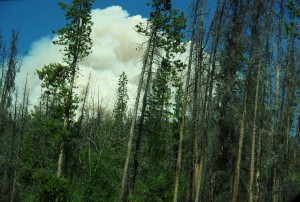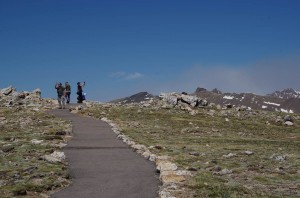12 June 2013
AGU Video: Big Meadows Fire: Connecting the dots between warming winters and wildfires while at AGU Chapman Conference in Colorado
Posted by mcadams
[youtube=http://www.youtube.com/watch?v=6rbvfsudbmM&feature=youtube_gdata_player]
Jeff Maugans, a retired district naturalist for the National Park Service, talks about the Big Meadows Fire on Tuesday afternoon while on a field trip in Rocky Mountain National Park as part of the AGU Chapman Conference on ‘Communicating Climate Science: A Historic Look to the Future.’
By Mary Catherine Adams
Granby, Colo.— The grayish puff clinging to the mountainside caught the climate scientists’ attention almost immediately. With no other clouds in the blue sky, the grey puff stood out.
“It’s a fire!” The twenty scientists seemed to identify the smoke at the same time, taking their cameras to one side of the bus to snap photos while touring Rocky Mountain National Park. The group was on an afternoon field trip near Granby, Colo., as part of the Chapman Conference on ‘Communicating Climate Science: A Historic Look to the Future.’
In minutes, the smoke grew from a small puff to a prodigious cloud. The scientists were watching the gestation of the Big Meadows Fire.

Dead lodgepole pine are seen in front of the Big Meadows Fire in Colorado's Rockey Mountain National Park on June 11, 2013. Photo by Olivia Ambrogio, AGU.
According to the National Park Service, the wildfire was started Monday night by a lightning strike from a passing thunderstorm. It burned throughout the night, but remained fairly small. By Tuesday afternoon, however, high winds had caused the fire to swell.
Because the fire was burning in a wilderness area of the Park, where it was unlikely to threaten people or property, tour guide Jeff Maugans wondered if the Park Service would let it burn. Maugans, a retired district naturalist for the Park Service, spent 19 years working in Rocky Mountain National Park.
In Smokey the Bear’s heyday, the Park Service considered all forest fires to be bad, Maugans said. Fires were fought vigorously, enabling dense young stands of trees to grow. But because the many trees were still using the same amount of resources, the young trees did not grow to be healthy and robust and were left vulnerable.
Enter the mountain pine beetle.
Mountain pine beetles feast on lodgepole pine, the primary tree species featured outside the group’s tour bus windows. The beetles can attack a tree in a horde, ultimately killing it.

Scientists attending the Communicating Climate Science: A Historic Look to the Future Chapman Conference in Granby, Colo., snap photos on a field trip to Rocky Mountain National Park on June 11, 2013. Photo by Olivia Ambrogio, AGU.
The beetle population is kept in check by cold winters. Specifically, about a week of freezing temperatures in December and 10 or so more freezing days in January will kill off enough of the larvae to keep the beetles in check, said William Hay, Professor Emeritus of Geological Sciences at the University of Colorado at Boulder and one of the Conference attendees.
Since the mid 1990s, winters have been too warm to kill off enough of the beetles, Hay said.
The result has been an epidemic and many dead trees – fuel for wildfires.
Because Colorado has had a milder winter this year, and more beetle larvae may have survived, Hay worries that this year will be especially bad for the trees. That, combined with the drought could mean even more wildfires.
“The wildfires up here are not fun,” says the Colorado resident. “They’re thoroughly scary.”
By Tuesday afternoon, the National Park Service announced that it had decided to begin fighting the Big Meadows Fire. Though the Park Service now prefers to let fires burn through the fuel load, or dead trees, the agency said it had decided to suppress this fire because of drought conditions and because the Service has limited resources for managing a long-term fire.
—Mary Catherine Adams is a public information specialist at AGU. She is on location at the Chapman Conference in Granby, Colo.


 GeoSpace is a blog on Earth and space science, managed by AGU’s Public Information staff. The blog features posts by AGU writers and guest contributors on all sorts of relevant science topics, but with a focus on new research and geo and space sciences-related stories that are currently in the news.
GeoSpace is a blog on Earth and space science, managed by AGU’s Public Information staff. The blog features posts by AGU writers and guest contributors on all sorts of relevant science topics, but with a focus on new research and geo and space sciences-related stories that are currently in the news.